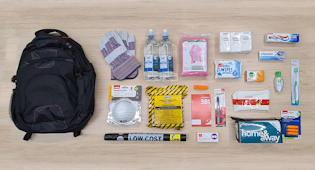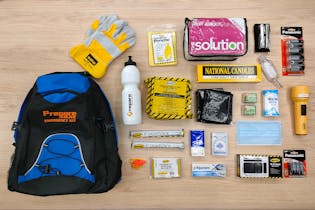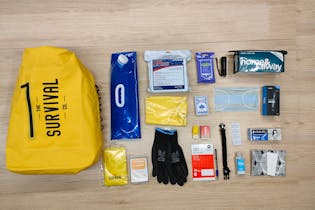We unpacked each grab bag and evaluated its comprehensiveness (completeness) and quality. A score is assigned for each, and those two scores are then averaged to provide the overall score.
Comprehensiveness
We created a DIY kit list, which is a combination of what’s recommended by the National Emergency Management Agency and some additional items we think are especially useful.
We think a commercially made grab bag should contain everything in that list, except those things that can’t be supplied by kit retailers, such as pain killers, clothing and personal items.
Since there are items that can’t be supplied in a pre-made grab bag, it’s essential that those kits include a clear and complete checklist of items that need to be added.
To get the comprehensiveness score, we compared what’s in each grab bag against the DIY kit list (excluding pain killers), including a checklist of items to be added.
Quality
We assessed how well each item in a grab bag does its job, how easy it is to use, and how durable we think it is. Each item was assigned a quality score. The overall quality score for a grab bag is based on the average of the quality scores of all the items it contains.
We paid close attention to what we regard as essentials in a grab bag. That includes the bag supplied, torch, radio, first aid kit, food rations and the checklist of items to be added. For the essentials, we assessed:
- Bag: size, type (shape), fit, comfort, zip smoothness, water resistance, durability, volume (whether there’s sufficient space for additional gear), number of compartments to organise gear.
- Torch: brightness, beam pattern, ability to read signage in the dark from two metres, perceived durability, runtime for wind-up models (after one minute of winding).
- Radio: number of channels (AM, FM1, FM2), number of stations received, reception clarity, sound quality, volume, ease of tuning, ease of reading controls, runtime for wind-up models (after one minute of winding). Each radio went through two performance tests – one ground floor and one basement. The scores of those two tests were then averaged.
- First aid kit: range of pieces including sizes, number of pieces, quality of pieces.
- Food rations: energy, nutrition, number of years to expiry at the date of supply.
- Checklist of items to be added: completeness, easiness to read, distinction between what's in the grab bag versus what’s to be added.
- Other items: general assessment of functionality and durability. Examples: A thick tear-resistant poncho with an adjustable hood scores higher than a basic very thin plastic one. Three or four N95 or P2 rated masks score higher than a single P1 or unrated mask. Alkaline batteries with a long shelf life score higher than poor performing carbon zinc ones.
Why is this free?
This report is free thanks to funding from the National Emergency Management Agency (NEMA) and Toka Tū Ake EQC.
We've tested several emergency grab bags and made one of our own. Find out how they compare.


